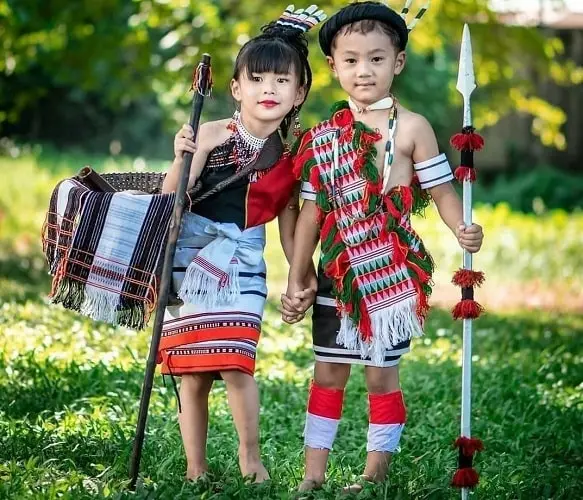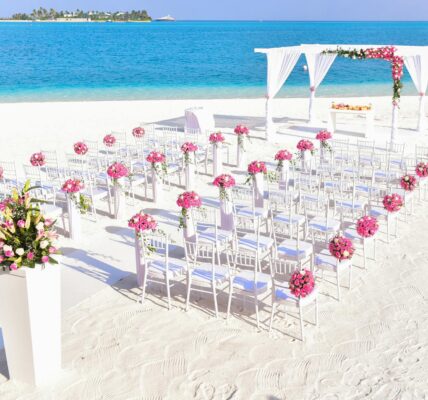Nagaland is a country with a vibrant culture and extensive traditions. It is located amid the verdant highlands of Northeast India. The traditional clothing of Nagaland constitutes one of the most fascinating features of its past. Nagaland’s natives take great delight in their distinctive attire, which exquisitely portrays their cultural identity. In this post, let’s examine the traditional attire of Nagaland, examining the distinctive designs and deft craftsmanship which make it so captivating.
Nagaland Traditional Dress for Male
The traditional clothing for men in Nagaland combines handwoven materials, elaborate patterns, and extravagant accessories. Their traditional clothing’s main components are:
1. Kilt
Manufactured from handwoven cotton cloth, the Kilt resembles a wraparound skirt. Typically, it is coloured in vivid hues like blue, red, or black. The Kilt is worn with a Tiekie, a woven belt with exquisite design and both practical and decorative use.
2. Angami/Mao Jacket
The traditional clothing must include the Angami or Mao jacket. The jacket is waist-length and features elaborate embroidery and motifs that showcase the Naga tribes’ artistic prowess. The jackets frequently feature shells, beads, and animal designs to highlight the tight relationship between their nature and culture.
3. Alungstu
Rich men in the area wear this, it is additionally a traditional outfit of Nagaland. These outfits represent success and wealth. These garments are decorated with flowers and contain a yellow dye. Only tribe members were responsible for creating these outfit designs.
4. Headgear and Accessories
Men frequently don accessories like the Tsungkotepsu, a bamboo hat embellished with feathers and vibrant threads. Additionally, they adorn themselves with necklaces, belts, and bracelets made of beads, shells, and animal bones. The overall outfit is given a refined touch by these accents.

Nagaland Traditional Dress for Female
Traditional Naga women’s clothing is a magnificent display of vivid hues, intricate weaves, and fine craftsmanship. Let’s look at the main elements of their traditional attire:
1. Risa/Shawl
Beautiful fine cotton or handwoven silk shawls are used to create the Risa. It is decorated with elaborate designs and patterns which represent different facets of Naga culture. Natural dyes are frequently used to create the shawls’ eye-catching hues of red, black, and yellow.
2. Puan/Skirt
Made of handwoven fabric, the Puan serves as a wraparound skirt. It is typically worn with a Zhiqre waist belt, that is embellished with shells, pearls, and metal objects. The variety of Naga clans is reflected in the skirts’ diverse patterns and hues.
3. Azu Jangup Su
Special occasions call for the wearing of skirts with red and yellow stripes.
4. Mechala
It is a piece of fabric worn around a skirt and shawl.
5. Neikhro
Naga women also don a different outfit called the Neikhro, which features a pattern like a petticoat. The pattern and colour of these outfits are what give this clothing its singularity.
6. Moyer Tusk
It is a common, dark blue piece of cloth. At the very end of the fabric, there is a band with zigzag designs.
7. Jewellery and Accessories
Naga women are known for their magnificent jewellery, which includes earrings, bangles, and necklaces. These items, which feature elaborate beading, are frequently handed down through the generations. The jewellery acts as a status and cultural heritage emblem in addition to adding a bit of glitz.
Nagaland Shawl
A shawl is a significant accessory worn by the people of Nagaland. One of the most popular local traditional outfits is the lovely shawl. Every tribe has a unique shawl that makes it simple to tell one tribe from another. The designs for each of these categories are then further subdivided into subcategories and categories. The shawl changes depending on the person’s position. Bridal Dress of Nagaland.
Nagaland Wedding dresses
If the bride and groom don’t wear the conventional wedding attire, the wedding ceremony will appear lacking in meaning or colour.
- Gown: The number of Christians is growing in the state of Nagaland. In Nagaland, the bride dons a white gown. Additionally, Nagaland’s Christian traditions include wedding rites. A crown or other headpiece is worn by the bride.
- Sarees: Certain brides also enjoy accessorizing their traditional saree with tribal jewellery. They like to preserve the old-fashioned flavour.
- Blazer/Suit: Christianity is growing in the state of Nagaland, blazer or suit. In Nagaland, the groom wears a black blazer, a tie around his neck, and a stone stud to give the outfit more style. Additionally, Nagaland’s Christian traditions include wedding rites.
Conclusion
The men’s and women’s traditional attire in Nagaland is a reflection of the region’s abundant cultural heritage. The intricate design, vivid colours, and significant motifs reveal the history, customs, and enduring ties to the nature of the Naga tribes. In addition to serving as clothing, the outfit serves as a symbol of the wearer’s identity, pride, and sense of community. The traditional attire is still treasured and worn on special occasions in Nagaland despite its embrace of modernity, protecting the priceless legacy of the Naga individuals for future generations.

Santosh Kumar is an editor at unfoldstuffs.com and a professional content writer. With years of experience he is passionate for creating engaging, informative and impactful topics.









